August 6, 2023
Hockey Help: Keeping you protected with protective gear
Stay Safe and Play with Confidence. Playing hockey is a blast, but safety comes first! From your head down to your toes, we’ve got your back with tips on buying and wearing the right gear. Let’s dive in!
Keeping your whole body protected is so important when playing sports, and especially important when playing hockey. Safety always comes first when stepping on the ice. Our next set of equipment pieces in our gear guide will keep you keep you that way!
We’ll start from the top…
Neck Guards: Play it safe.
When purchasing a neck guard, it’s important to make sure the one you are purchasing is certified to ensure it will keep your neck properly protected.
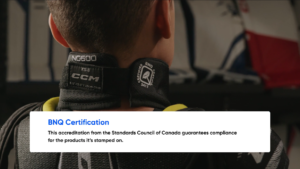
There are different styles to consider that can be chosen based on personal preference. Depending on if you want extra padding or a stronger degree of impact protection, it’s important to try a couple of different styles to decide which one you’re most comfortable in.
Neck guard fitting tips:
• Make sure that at least ¾ of your neck is covered
• Don’t have it sitting loose on your neck
• It should feel snug or like turtleneck, to ensure it is protecting you properly
For more on neck guards check out The Essential Hockey Neck Guard Buying Tips Every Player Should Know from our Hockey Help series
Shoulder & Elbow Pads: Protect with style
When talking about shoulder pads the first step is to determine if you are playing contact or non-contact, most youth and adult leagues are non-contact so that’s not going to be a big factor and will help to narrow your search for the right shoulder and elbow pads.
When looking for shoulder and elbow pads you want to make sure everywhere that needed to be protected, is protected.
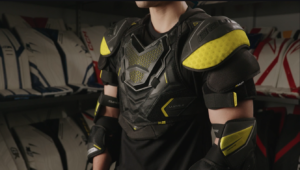
For shoulder pads you are going to want to have these areas covered:
Shoulders Collar bones Front sternum & chest Back Biceps
For elbow pads you want to make sure it’s snug, but you are able to flex, and the elbow pad won’t move on its own, and to have these key areas covered:
Funny bone Biceps Forearm
Size and Fit
When trying to pick out the right fit for your shoulder and elbow pads it’s important to note that a lot of hockey brands out there, created a variety of sizes and styles to help fit a greater range of body shapes. Some are a more of a traditional shape and some are a bit more tapered. It’s best to try on a few different ones to find the one that best fits your body.
When deciding on sizing you are going to want to make sure your shoulder cap is covering the center part of your shoulder. You have protection on your chest that’s not too low so it won’t impede your stomach as you move. That you have coverage on your collar bone, your back has coverage and the bicep pad is about ¾ of the way down.
Tips:
• Make sure the center part of your shoulder cap is fully covered.
• Your chest should also be covered; however, the pads shouldn’t limit your movement.
• Try and make sure the bicep pads are roughly ¾ of the way down
Contact league or not, you should have these as there is nothing wrong with having too much protection. With lots of different styles and brands of shoulder and elbow pads, there are a variety designs that can give you a lot of flexibility and the basic coverage you need.
You don’t need to buy both pieces of equipment at the same time, as kids grow differently. They may grow out of the shoulder pads and their elbow pads still fit properly.
Want more info on your shoulder pads? Check out our video in our Hockey Help series Mastering Shoulder Pads: The Ultimate Guide For The Perfect Purchase
Gloves: Feel Good, play great
Gloves are designed to give you the protection your hands need on the ice and allow you to feel good gripping your stick while you play. You don’t want a pair with too much protection, as they will be too stiff and limit your range of motion.
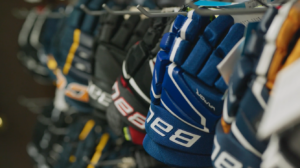
There a different style and designs you can choose from when picking out your gloves such as:
A traditional fit that has more room inside the glove for motion
Tapered fit which is designed to be an extension of your hand and is more form-fitting
When picking out your gloves you can chose from a variety of styles and designs. It’s up to you on colour you want, from wearing your favourite to matching your team, you can look and feel your best.
Sizing & Fitting tips:
The sizing and fit of your gloves, has no sizing chart or measurement system. So when picking out your gloves, you’re going to want to try a couple pairs on to see which ones give you the best range of motion and best control.
When it comes to how big they should be, it depends on your age group. For kids who are still going to be growing, you should buy a pair that is a bit bigger, so they can last a bit longer. Keep in mind that they still need to have full control of the glove. Whereas for adults, you should make sure you have full control of the glove. It should be nice and firm but not too tight that you could hurt your finger. Overall, if you’re fully covered and feel comfortable, your gloves should keep you safe.
Want more info on buying gloves? Head to our Hockey Help series and check out From Snug to Superior: The Art of Picking Hockey Gloves Like a Pro
Jock & Jill & Pants: Guard your lower half
Hockey pants are designed to provide protection against more than just the boards and other players. They are made to protect your kidneys, thighs, lower back and give some protection to your tailbone.
When it comes to keeping you safe and protected while on the ice, you can’t forget the need to protect your lower regions. It’s best that you find one that suits your needs, and keeps you protected. There are 2 types of protection that you can use, a jock cup/strap, which is typically used for men, or a jill strap that is typically used by women.
Size and Fit
When trying on a pair of hockey pants even though they are technically shorts, you want to make sure they fit as such:
• Make sure to have your pants sitting on your waist
• The bottom should fall right around the top of your knee
• For kids, it shouldn’t be lower than halfway down their knees
• Make sure your pants feel comfortable
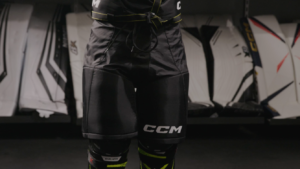
When buying hockey pants for kids who are still growing, you can buy them a little bit big. You can also purchase a pair that will grow with your kid as they continue to grow, as they are adjustable in length, so they will last longer.
There are different styles of jocks and jills. There’s the standard kind of just the strap, or there is also compression/mesh shorts. Most of these will have a garter belt, so they’re able to hold your socks up over your shin guards. When finding the right sizing for your jock or jill, go by the size of your waist or, some shorts will have a draw string or elastic waist band as well. It’s important to pick the style and type that best fits you and is the most comfortable.
To learn more about hockey pants, jocks and jills, check out our video from our Hockey Help series: Hockey Pants: The Secret To Buying The Perfect Pair
Shin Pads: Defend those shins
Shin pads are an essential piece of equipment that should always be worn during a game. They provided players with the protection for your shins, knees, and even your calf muscles. It’s important to know that hockey shin guards are much different than soccer shin pads. Hockey shin pads are thicker so they can protect you from flying pucks, skates and “accidental” stick slashes.
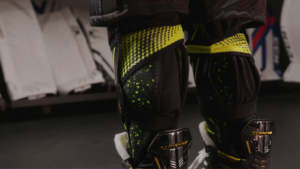
Size and Fit
When trying on a pair on shin pads for the first time, you want to make sure they fit properly. You don’t want them to be too long to the point where they restrict your movement, but also want to ensure they give the protection you need.
Some tips to make sure they fit properly are:
• Knee protector should rest in the center of your kneecap
• They should go straight down to your ankle
• Make sure they are snug and don’t go too long
When buying for kids, you can buy them a bit longer, but make sure that they aren’t sitting on top of the skates, this will make it difficult to turn on the ice.
Find out more on shin pads by checking out our video from our Hockey Help series: Don’t Make These Mistakes When Buying Shin Pads
Taking Care of your Equipment: Play it safe
Overall, your hockey gear can last you multiple years if properly taken care of. Most of your equipment you’ll want to keep dry. This can be done by hanging your gear up after an ice time, to air it out (this also helps with smell).
Some pieces can be washed such as your jock/jill and sometimes the padding of your shin guards. But when your equipment starts to wear out, it’s best to replace it and start fresh, instead of repairing it.
Cost of the equipment: Stay budget savvy
The costs of your protective equipment depend on the style, brand, fit and comfort level you decide to go with.
Youth hockey pants: $40-50
Adult hockey pants: $70-80
Jock & Jill – traditional: $15-20
Jock & Jill – shorts: $30-50
Youth shin pads: $30-40
Adult shin pads: $60-80
Youth shoulder pads: $30-50
Youth elbow pads: $25-30
Adult shoulder pads: $60-80
Adult elbow pads: $45-50
Youth gloves: $35-50
Adult gloves: $70-90
Now that’s a lot of information! Didn’t catch it all? No worries, check out all the links to our Hockey Help video series for more, or just come back here when you’re at the store. Now you’re geared up to hit the ice with confidence. Stay safe, have fun, and play your heart out!

